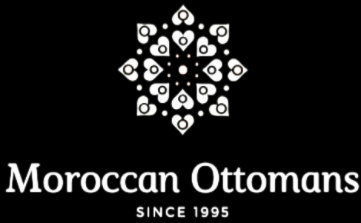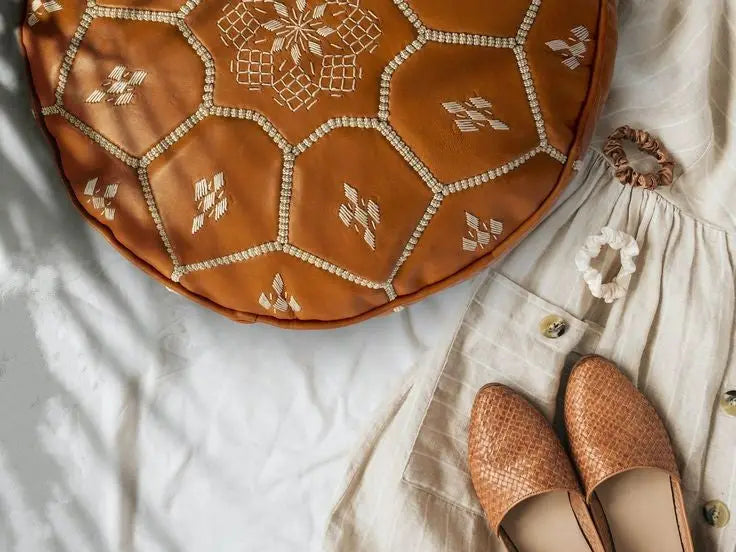
Moroccan Pouf and Interior Decoration
Share
At the crossroads of exquisite comfort and captivating elegance, the Moroccan pouf is a must-have piece for transforming your living room into a space that's both welcoming and chic. By skillfully blending Moroccan artisan traditions with contemporary decorating trends, the Moroccan pouf transcends cultural boundaries and offers an authentic touch to any space.
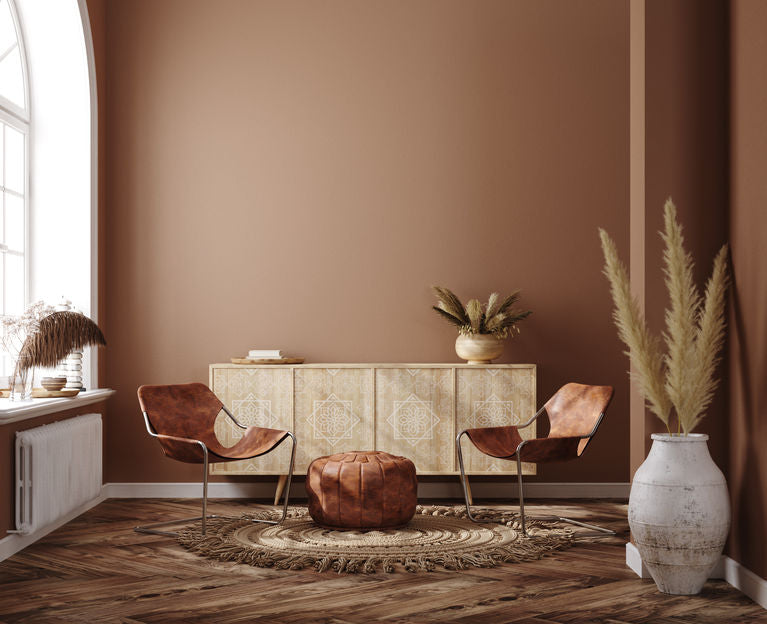
This article invites you to delve into the sumptuous world of Moroccan design and discover how the timeless charm of the Moroccan pouf can redefine the very concept of comfort and elegance in your home.
What is a Moroccan pouf?
A Moroccan pouf is a low, cushion-like seat made of natural leather or woven fabric, traditionally handmade by skilled artisans in cities like Marrakech and Fez. They come in a variety of shapes, colors, and patterns, often adorned with hand-embroidered or decorative motifs. Most are filled with cotton, wool, or recycled materials, making them both durable and long-lasting.
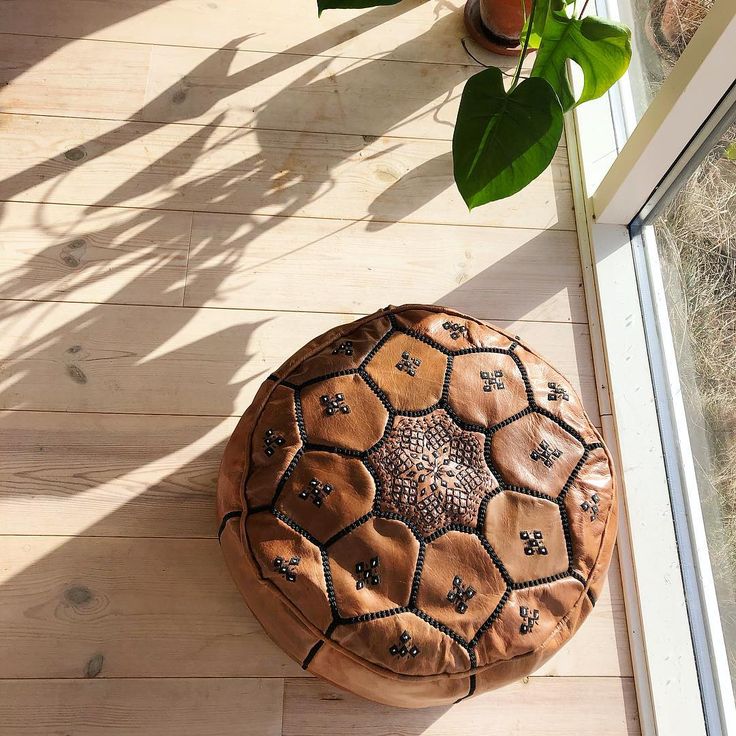
The Moroccan pouf originated in Marrakech, Morocco, where it has been made for centuries. Traditionally, poufs were used for seating around low tables during social gatherings and family meals. Over the years, the pouf became a popular decorative accessory in Moroccan homes and was eventually exported to other countries.
The Moroccan pouf, also known as the “Marrakech pouf,” is a traditional Moroccan home decor accessory that has become popular worldwide for its beauty and comfort. Handcrafted using traditional weaving and embroidery techniques, the Moroccan pouf is not only an attractive decorative piece, but it is also functional and comfortable.
What are the Moroccan artisan influences in pouf design?
Moroccan artisan influences play a major role in the conception and design of the pouf, creating a harmonious fusion of tradition and modernity. Moroccan artisans have passed on their ancestral know-how through this iconic piece of furniture, making the pouf much more than a simple seat, but a true functional work of art.
Cultural Heritage and Artisanal Techniques
The design of the Moroccan pouf reflects the country's rich cultural heritage, incorporating traditional motifs such as zelliges, arabesques, and Berber weaving. Artisanal techniques such as leatherwork, embroidery, and loom weaving are used to create unique pieces, demonstrating the artisans' dedication to their craft.
Authentic Materials and Durability
Moroccan poufs are made from local materials such as leather, fabric, and natural fibers, providing exceptional authenticity and durability. Goat leather, for example, is crafted using traditional methods to achieve luxurious finishes and a comfortable feel.
Contemporary Adaptation
The design of the Moroccan pouf has also evolved to meet contemporary tastes. Variations in shapes, colors, and sizes are observed, while preserving the characteristic elements of Moroccan craftsmanship. This skillful adaptation allows the pouf to blend harmoniously into modern interiors while recalling its traditional origins.
International Influence
Thanks to their unique aesthetic, Moroccan poufs have won an international audience. They have become sought-after pieces in the world of interior design, transcending cultural boundaries and becoming symbols of elegant Moroccan craftsmanship worldwide.
How does the Moroccan pouf combine contemporary comfort with authentic charm?
The harmonious marriage of contemporary comfort and the authentic charm of the Moroccan pouf
The Moroccan pouf embodies a successful fusion of modern comfort and the irresistible charm of tradition. With its origins dating back centuries, this iconic Moroccan piece of furniture continues to seduce thanks to its ability to combine seemingly contradictory elements.
A timeless design imbued with authenticity
The Moroccan pouf draws its authentic charm from its intricate geometric patterns and finely crafted details. These features reflect Morocco's rich cultural heritage, bringing a touch of history to any contemporary space.
Enveloping comfort with modern accents
Despite its traditional appearance, the Moroccan pouf offers contemporary comfort thanks to its ergonomic structure and soft padding. The use of high-quality materials guarantees an optimal relaxation experience, satisfying the expectations of modern design aesthetes.
Adaptability and Versatility in Various Decors
The versatility of the Moroccan pouf lies in its ability to blend harmoniously into various interior settings. Whether as a footrest in a minimalist living room or as an informal seat in a reading nook, its subtle presence adds an effortless touch of elegance.
A Heritage Preserved in a Modern Era
The Moroccan pouf not only represents the past; it also serves as a bridge between tradition and contemporary design. By keeping its artisanal heritage alive through updated designs, it reminds everyone that authenticity and comfort can coexist in a harmonious and inspiring way.
In short, the Moroccan pouf transcends eras and styles by embodying a perfect balance between modern comfort and authentic charm. It is a tangible reminder that timeless elegance can be fused with the conveniences of our contemporary era.
How does the Moroccan pouf redefine the concept of comfort and elegance in your home?
The Moroccan pouf, a symbol of exoticism and refinement, transcends the norms of comfort and elegance in your living space. With its unique fusion of tradition and modernity, this versatile piece of furniture offers much more than just a place to sit—it embodies a cultural and artistic experience.
Authentic craftsmanship:
Each Moroccan pouf is meticulously handcrafted by experienced artisans, who pass on their ancestral know-how through every stitch and weave. These unique pieces carry the history and authenticity of a centuries-old tradition.
Enveloping Comfort:
The Moroccan pouf is distinguished by its generous padding made of natural materials such as supple leather or soft cotton. This design creates a seat that is both supple and sturdy, adapting perfectly to the shape of your body for optimal comfort.
Sophisticated Elegance:
Timeless and elegant, the Moroccan pouf's design blends harmoniously with any decor. Its intricate details and captivating patterns add a touch of sophistication to your interior, instantly transforming the ambiance of the room.
Modern Versatility:
In addition to serving as seating, the Moroccan pouf can serve as a footrest, a side table, or even a decorative centerpiece. Its functional versatility makes it a must-have for optimizing the use of your space.
In short, the Moroccan pouf goes beyond a simple piece of furniture, it redefines the idea of comfort by embracing cultural authenticity and timeless elegance, while adapting perfectly to modern needs for versatility.
How to incorporate the Moroccan pouf to create a welcoming and chic living room?
Decorating with Moroccan poufs can transform your space into an exotic and welcoming haven. These handcrafted pieces, rich in history and culture, add a touch of elegance to any interior. Discover in this article seven steps to incorporating these magnificent poufs into your interior design.
Choose the Right Pouf
Choosing the right pouf is crucial. Moroccan poufs come in various shapes, sizes, and colors. Choose authentic materials like leather or hand-embroidered fabric. For a traditional look, opt for geometric patterns and warm colors. Poufs made of brown leather or bright colors like red and blue are very popular.
Find the Perfect Location
The placement of the Moroccan pouf can make all the difference. Place it in a place where it is easily accessible and visible, such as the living room or bedroom. Moroccan poufs are perfect as extra seating, footstools, or even as coffee tables with a tray.
Match with your existing decor
Make sure the pouf complements the rest of your decor. If you have a modern interior, choose a pouf with clean lines and muted colors. For a more traditional interior, a pouf with vibrant patterns and colors will be ideal. The important thing is to create visual balance and avoid style clashes.
Use poufs to create relaxation areas
Moroccan poufs are perfect for creating relaxation areas. Place several poufs around a coffee table for a reading nook or conversation area. They can also be used in a sunroom or corner of the home for a relaxing meditation space.
Accessorize with Moroccan elements
For a cohesive decor, add other Moroccan decorative elements. Berber rugs, metal lanterns, embroidered cushions, and mosaic tables perfectly complement Moroccan poufs. These accessories will reinforce the theme and add visual richness to your space.
Experiment with textures and colors
Don't be afraid to play with textures and colors. Mix and match different Moroccan poufs for a bohemian chic effect. Pair them with soft textiles like wool throws or silk cushions for an interesting contrast. Texture combinations will add an extra dimension to your decor.
Consult decoration specialists
If you want a professional and personalized finish, consult Moroccan decoration specialists. Experts like Full Décorateur can help you integrate Moroccan poufs harmoniously and elegantly into your interior. To obtain a Moroccan decoration quote, don't hesitate to contact these professionals who will be able to guide you in your choices and create a space that reflects your personality.
Decorating with Moroccan poufs is a wonderful way to add an exotic and sophisticated touch to your home. By following these seven steps, you can incorporate these handcrafted pieces in an elegant and functional way. Don't forget to coordinate colors and experiment with textures to achieve a perfect result.
What complementary decorative elements will enhance your Moroccan pouf?
Poufs have a plush surface made of leather or fabric, so any elements are naturally softened and texturized. In a living room, try a Moroccan Pouf as a coffee table: place a tray with a vase, a tray with a candleholder, or a coffee table book.
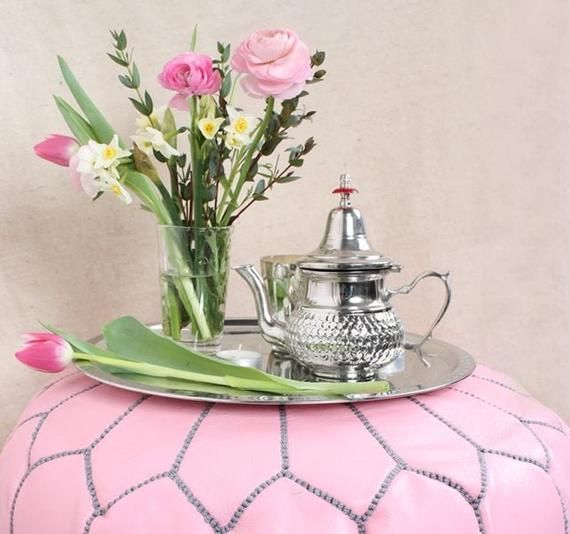
If you want to speak to an pouf's plush/fabric/seating elements (as opposed to a table function), layer on a throw blanket over the side of a pouf, contrasting colors and textures for style.
Why do Moroccan poufs fit perfectly into bohemian interiors?
Bohemian interior design favors eclecticism, rich textures, and pieces rich in history. Moroccan poufs tick all these boxes. Their soft edges and handcrafted beauty complement layered textiles, vintage rugs, and natural elements like wood, rattan, and greenery. They're perfect as floor seating for casual gatherings or as a footrest next to a chaise lounge or sofa.
Layer a colorful pouf next to a jute rug and a macrame wall hanging for an instant bohemian vibe. You can also mix and match poufs in different shades, such as natural tones, deep burgundy, or classic beige, to add warmth and visual appeal without overwhelming the space.
Functional and Trendy
Beyond their aesthetic appeal, Moroccan poufs are incredibly functional. Use them as extra seating for guests, a coffee table with a tray, or a plush play surface for children. Their compact size makes them perfect for small apartments or multipurpose rooms. And because they're lightweight, they can be easily moved wherever you want.
Ethically Made and Rich in Culture
One of the most compelling reasons to incorporate Moroccan poufs into your home is their origin. Each pouf supports Moroccan artisans who use time-honored techniques to create unique pieces. By choosing ethical decor, you not only beautify your space, but also help preserve traditional craftsmanship and support fair trade practices.
In Conclusion
Moroccan poufs are more than just a trendy decor item: they're timeless expressions of culture and craftsmanship. They embody the bohemian chic spirit: relaxed, international, authentic, and elegant. Whether you're new to bohemian design or looking to refresh your home, a Moroccan pouf is a meaningful and versatile addition that brings your space to life.
